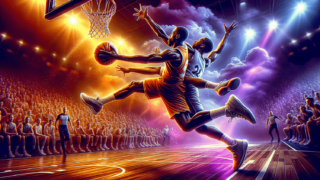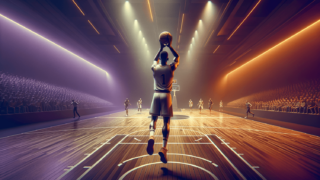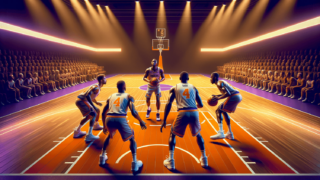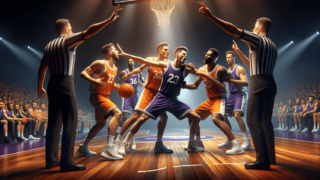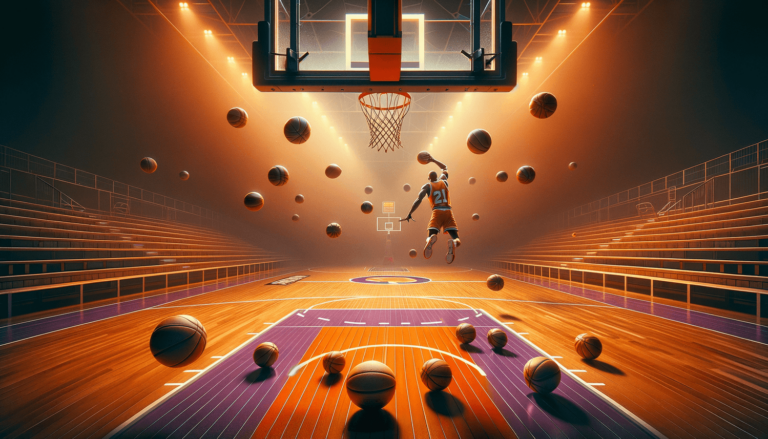
No Dunking Rule in Pre-Game Warmups: Why It Exists
Written by: Basketball Universe
Last updated:

In the high-stakes world of basketball, every aspect of the game is nuanced and governed by a set of rules designed to maintain order and optimize performance. Yet, there’s one rule that has piqued the curiosity of enthusiasts and seasoned fans alike: the No Dunking Rule during pre-game warmups. Why does this seemingly unassuming regulation exist? Stick around, as we dive into the captivating history, the fascinating reasons behind its implementation, and the effects that this rule has had on the dynamic game of basketball.
No Dunking Rule in Pre-Game Warmups: Why It Exists
The No Dunking Rule in pre-game warmups exists primarily to minimize the risk of injury to players and to prevent potential damage to the basketball hoops before the actual game commences. By discouraging players from performing high-intensity dunks during warmups, the rule ensures they save their energy for the game and maintain the integrity of the equipment, thus contributing to a smooth and uninterrupted match for both the players and the fans.
A Stroll Down Memory Lane: The Origin of the No Dunking Rule
Though often thought of as a modern regulation, the No Dunking Rule during pre-game warmups actually has a rich history, dating back to the early days of basketball. To fully understand the rationale behind this rule, let’s take a brief trip down memory lane and delve into the events that shaped its existence.
Breaking Backboards: The Darryl Dawkins Incident
In 1979, Darryl Dawkins, aka “Chocolate Thunder,” was making waves with his monstrous dunks, shattering a backboard in dramatic fashion with his high-flying signature move. Dubbed “The Chocolate-Thunder-Flying, Robinzine-Crying, Teeth-Shaking, Glass-Breaking, Rump-Roasting, Bun-Toasting, Wham-Bam, Glass-Breaker-I-Am-Jam,” the incredible moment garnered widespread attention, eventually leading to discussions surrounding player safety and equipment durability.
Raining Glass: The NBA Takes Action
In 1981, the NBA introduced the “Dawkins Rule,” a regulation specifically aimed at preventing players from breaking backboards by hanging on the rim after a dunk. Over time, this rule and increased durability in equipment helped curb the occurrence of shattered backboards, but it did little to address the inherent risks associated with high-intensity warm-ups for players.
Injury Prevention: The Central Focus of the No Dunking Rule
As basketball continued to evolve and athletes pushed the boundaries of their physical capabilities, so did the risk of injury during pre-game warmups. Slam dunks, though breathtaking to behold, leave players susceptible to injury due to the intense nature of the move. With the importance of player health and longevity at the forefront, the league decided to tackle this issue head-on by introducing the No Dunking Rule during pre-game warmups.
The Dangers of Dunking in Warmups
Warmup sessions are crucial to preparing a player’s body for the rigorous physical toll that a basketball game demands. A typical basketball warmup is not only used to increase a player’s core temperature but also to enhance their proprioception (the ability to sense the position of their body in space) and dynamic balance for improved performance.
Dunking during warmups, however, amplifies the risk of injury as it involves an explosive movement that combines vertical leaps, sudden acceleration, and powerful use of the upper body. The list of injuries that could occur from dunking includes but is not limited to:
- Ankle sprains
- Knee injuries (e.g., ACL tears or patellar dislocations)
- Wrist sprains
- Shoulder injuries (e.g., dislocations or labral tears)
- Finger injuries (e.g., dislocations, sprains, or fractures)
Recovery Time and Missed Games: A Costly Affair
Injuries sustained during pre-game warmups can have a significant impact on a player’s career and a team’s performance. As high-profile athletes, players bring immense value to their respective teams, and their absence due to injury can result in a drop in the team’s overall performance, ticket sales, and even team morale. Moreover, the financial implications of treating and rehabilitating injured players can put a substantial strain on an organization’s resources.
Protecting Equipment: Ensuring a Smooth Game Experience
The Effects of Repeated Dunking on Basketball Hoops
Though modern basketball hoops and backboards are designed to withstand the force of powerful dunks, repeated dunking during pre-game warmups can still cause unnecessary wear and tear on the equipment. Excessive strain can lead to loosening of the hoop, backboard instability, and in some cases, even structural failure.
Equipment Malfunction: A Chain Reaction of Delays and Disruptions
When equipment malfunctions occur, there is a potential for a series of disruptive consequences that affect not only the players but also the fans in attendance. Some possible disruptions include:
- Delays in game start times
- Lengthy mid-game interruptions for equipment repairs or replacements
- Disgruntled fans and decreased spectator enjoyment
- Unexpected costs related to equipment repair or replacement
In order to maintain the integrity of essential game equipment and ensure a seamless, enjoyable experience for both players and fans, it became increasingly important to regulate player actions during pre-game warmups.
Basketball Rules Foster Discipline and Professionalism
While the No Dunking Rule in pre-game warmups has clear benefits for injury prevention and equipment preservation, it is also indicative of the league’s focus on fostering discipline, professionalism, and respect for the game. By implementing this rule, players are reminded to maintain a level of decorum and focus on the task at hand, rather than getting carried away with showboating.
A Gentle Reminder of Sportsmanship
The No Dunking Rule serves as a subtle reminder to athletes that basketball is, above all, a team sport that emphasizes sportsmanship, camaraderie, and respect for fellow competitors. By discouraging flashy performances during warmups, athletes concentrate on preparing for the game and supporting their teammates, rather than turning the warmup session into a spectacle.
Exceptions and Consequences: Upholding the No Dunking Rule
Rare Exceptions to Rule Enforcement
While the No Dunking Rule in pre-game warmups is a steadfast regulation, it is important to note that there are occasional exceptions during special events such as All-Star weekend festivities, where players are encouraged to showcase their skills in a more light-hearted setting.
Penalties for Rule Violations
Players who disregard the No Dunking Rule during pre-game warmups can face consequences ranging from warnings to fines imposed by the league. This system of penalties reinforces the importance of adhering to basketball rules and preserves the spirit of fair play and professionalism that the game demands.
Conclusion
While the No Dunking Rule in pre-game warmups may seem like a trivial regulation, its existence is grounded in the protection of players, the preservation of equipment, and the cultivation of specific values within the sport of basketball. By adhering to this rule as part of a larger framework of basketball rules, players, teams, and spectators can enjoy a safer, smoother, and more professional game experience.
Players’ Perspectives and Adjustments
Although the No Dunking Rule in pre-game warmups is primarily a safety measure, it’s essential to understand how it affects the players themselves, their perspectives on this regulation, and the adjustments they have to make to stay engaged and get the most out of their warmups.
Adjusting Warmup Routines: A Balancing Act
Considering the restriction on dunking, players have to adapt their warmup routines to focus on other aspects of the game that can prepare them both mentally and physically. These adjusted routines often include:
- Dynamic stretching to increase muscle flexibility and range of motion
- Shooting and layup drills targeting various spots on the court
- Ballhandling exercises to hone control and coordination
- Team drills focusing on offensive and defensive plays
By incorporating these elements into their warmups, players can maintain high-performance levels despite the absence of dunking and ensure that they are adequately prepared for the game.
Player Opinions: A Mixed Bag
Players’ opinions on the No Dunking Rule are varied, with some fully supporting the rule and others expressing their desire to have it relaxed. Some believe it limits their ability to enter the game with a performance mindset, but most are aware of the reasons for the rule’s implementation and the importance of protecting themselves and the equipment.
Promoting New Skills and Creativity
One of the unintended but noteworthy consequences of the No Dunking Rule during pre-game warmups is its role in promoting the development of new skills and fostering creativity among players.
Emphasis on Technical Skill Development
Pre-game warmups, free from dunking, require players to focus on refining their other skills to maximize team performance, such as shooting, passing, or ball handling. Players learn to think and execute plays critically and efficiently, which can ultimately lead to more success on the court.
Creative Approaches to Warmups
The No Dunking Rule has given rise to some unique and creative methods for players to engage and energize themselves, their teammates, and the crowd during pre-game warmups. By considering alternative ways to captivate onlookers, players have developed innovative methods such as intricate passing patterns, dazzling ball-handling routines, and flashy layup drills, allowing them to generate excitement and prepare for the game without breaking any rules.
External Factors: The Influence of College Basketball
The No Dunking Rule in pre-game warmups is not exclusive to professional basketball. College basketball has also implemented a similar regulation, reinforcing the importance of preserving equipment, protecting players, and promoting fair play at all levels of competition.
Consistency in Regulations Across Levels
Having these rules consistently applied across high-level basketball environments helps to establish a standard of professionalism and respect within the sport while preparing younger players for the realities of playing at a professional level. This consistency ensures that athletes have a smoother transition when navigating the various stages of their basketball careers.
Impact on NBA Scouting and Recruitment
With the enforcement of such rules in college basketball, scouts and recruiters who attend college games can focus on identifying players who excel in fundamental skills and exhibit discipline on and off the court. This focus on the broader aspects of the game positively affects the scouting and recruitment process for professional leagues like the NBA, ultimately leading to the selection of well-rounded athletes equipped to contribute significantly to their teams and the sport overall.
FAQ: No Dunking Rule in Pre-Game Warmups
Here are some frequently asked questions about the No Dunking Rule in pre-game warmups, covering various aspects of this regulation and its effects on the players, game, and equipment. This section will further aid in comprehending and demystifying the rule for basketball fans and enthusiasts.
1. Why does the No Dunking Rule exist during pre-game warmups in basketball?
The No Dunking Rule exists to minimize the risk of injury to players, prevent potential damage to basketball hoops, promote professionalism and fair play, and ensure a smooth, enjoyable experience for fans.
2. Does the No Dunking Rule apply to all levels of basketball?
While the No Dunking Rule is more common in professional and college basketball, other levels of competition may also choose to impose such rules, depending on circumstances and organizational preferences.
3. Can players be fined for breaking the No Dunking Rule during pre-game warmups?
Yes, players who disregard the No Dunking Rule during pre-game warmups can face consequences ranging from warnings to fines imposed by the league.
4. Are there any exceptions to the No Dunking Rule during pre-game warmups?
Rare exceptions to the rule enforcement may occur during special events like All-Star weekend festivities, where players showcase their skills in a more light-hearted setting.
5. How does the No Dunking Rule impact a player’s warmup routine?
Players adjust their warmup routines to accommodate the No Dunking Rule, focusing on dynamic stretching, shooting and layup drills, ball handling exercises, and team drills to prepare themselves for the game.
6. What’s the connection between the No Dunking Rule and the “Dawkins Rule”?
The “Dawkins Rule” was a regulation introduced in response to Darryl Dawkins’ backboard-shattering dunk in 1979 to prevent players from hanging on the rim after a dunk. The No Dunking Rule during pre-game warmups is a related, but separate regulation aimed at reducing injury risks and preventing equipment damage before the game commences.
7. Does the No Dunking Rule contribute to skill development for athletes?
Yes, the No Dunking Rule inadvertently promotes the development of other skills and creativity among players, encouraging them to focus on shooting, passing, and ball handling while preparing for the game.
8. How does the No Dunking Rule impact the experience of fans attending a game?
The No Dunking Rule helps ensure a smooth and enjoyable experience for fans by preventing delays, equipment issues, and game interruptions, maintaining an optimal atmosphere during the game.
9. Is the No Dunking Rule effective in reducing injuries during pre-game warmups?
While it’s difficult to provide definitive statistics, the No Dunking Rule is generally seen as effective in reducing the risk of injuries caused by the high-intensity and explosive movements associated with dunking during pre-game warmups.
10. Is there any chance the No Dunking Rule in pre-game warmups could be relaxed in the future?
Rules regarding behavior and safety are subject to continuous evaluation by league officials. While there is always the possibility that the No Dunking Rule may be modified, the current emphasis on preserving player safety, equipment, and professionalism makes it unlikely to change in the near future.
Featured Posts
- No pillar pages found.

